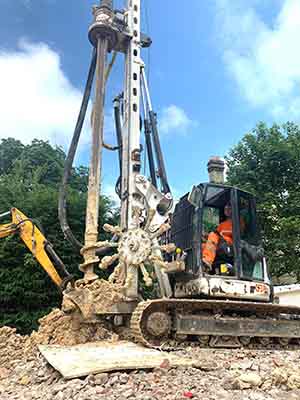To put it simply, pile essentially a long cylinder made from a strong material which is concrete, that is pushed into the ground and acts as a support for the structure built on top of it.
Foundation piling London is generally used in the following situations:
If there is a layer of weeks soil at the surface. This layer is unable to support the weight of the building, so the load weight of the building must bypass this layer and instead be transferred to a layer of stronger soil or rock below the weekly.
When the building hangs heavy, concentrated loads, such as high-rise structures, water tanks, and bridges.
Pile foundation is able to take a much heavier load than a regular spread footing.
There are two fundamental kinds of pile foundation and they both work in their own way. Piling contractors in London can determine the right kind pile foundation for the job based on structural behavior.
End Bearing Piles
With end bearing piles, the bottom of the pile rest on a layer of particularly strong soil or rock. The load from the building will be transferred through the pile into the stronger layer. This essentially acts as a column. The key principle of this kind of pile is that the bottom and will rest on the surface between a weak and strong player. The load was therefore bypassed this week layer and will be transferred safely to the strong player.
Friction Piles
Friction piles work differently. This kind of pile transfers the load from the building to the soil across the entire height of the pile using friction. This basically means that the entire surface of the pile, which is cylindrical in shape, will transfer the force to the soil.
You can get a good idea of how this all works by imagining that you are pushing a solid metal rod into frozen ice cream. After pushing the rod in, it is strong enough to support a load. The further the rod is embedded into the ice cream, the bigger the load it can support. This is similar to how friction piles work. With a friction pile installed by a piling contractor in London, how much of the load the pile can support is directly proportional to how long it is.
What are Piles Made From?
Piling companies in London will make their piles from wood, concrete, or steel.
Wooden piles were used as part of traditional construction, to support buildings and areas with weak soil. These days would piles are still used for constructing jetties. The length of the pile is limited to the length of one tree, which is about 20 m, since two tree trunks cannot be joined together. The city of Venice in Italy is famous for being constructed on wooden piles built over seawater.
Piling companies in London precast concrete piles, making them at ground level, before hammering them into the ground. Steel H-piles can also be driven into the ground. These kinds of piles are able to take on very heavy loads and can save time during construction. This is because there is no need to cast the pile first. The steel is not given a protective coating, as it would be scraped away by the soil. Concrete piles are best used in places with corrosive soil.
Get in touch today to learn more about piles, and arrange for a free consultation to learn which kind of pile is best for your property.


